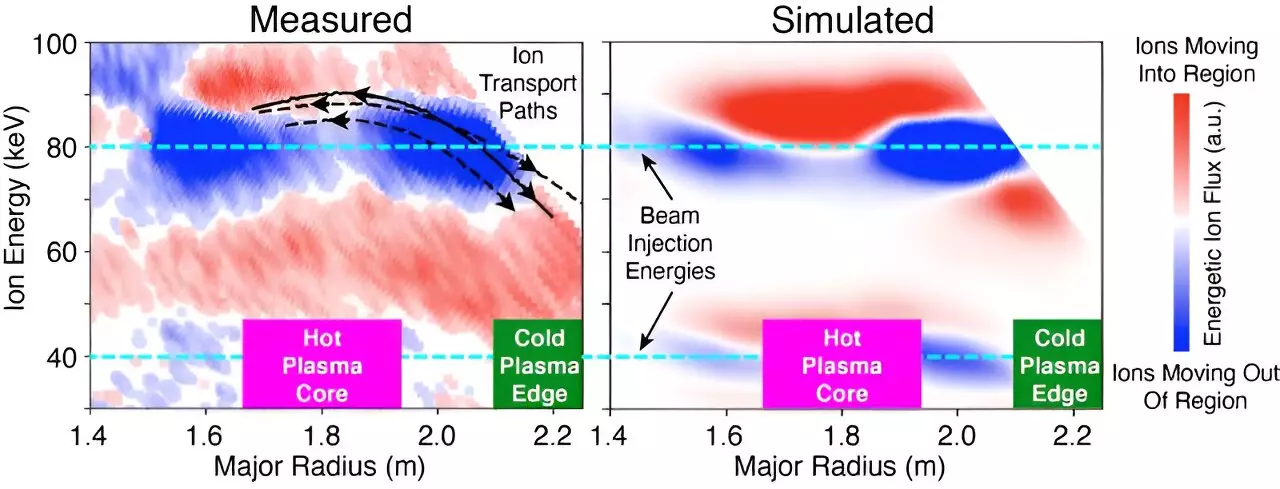In the pursuit of producing energy through fusion, maintaining the confinement of fusion-produced energetic ions is crucial. However, the presence of electromagnetic waves in fusion plasmas poses a significant challenge as they can push these ions out of the plasma, impeding the heating of the plasma and ultimately terminating the burning plasma state. Recent breakthrough observations at the DIII-D National Fusion Facility offer new insights into the movement of energetic ions within a tokamak and their interaction with plasma waves. By combining advanced computer models with these measurements, researchers have enhanced their understanding of the interplay between plasma waves and energetic ions, leading to potential advancements in fusion research, as well as applications in satellite reliability.
With plasma physics and fusion research transitioning from experimental facilities to demonstration power plant designs, there is a growing need for accurate simulations and predictive tools. While most current facilities do not generate burning plasmas, researchers have gained considerable knowledge in the relevant physics and are actively developing simulations to replicate observed experimental behavior. To expedite this progress, the researchers at the DIII-D National Fusion Facility conducted groundbreaking measurements of energetic ion flow in the tokamak, enabling the development of more comprehensive models that incorporate all pertinent wave-ion interaction dynamics. This newfound understanding also facilitates the application of phase-space engineering, a technique that allows researchers to design fusion plasma scenarios based on idealized predictions of wave-ion interactions.
At the heart of these advancements lies the Imaging Neutral Particle Analyzer (INPA), a diagnostic system developed at the DIII-D National Fusion Facility. This state-of-the-art system captures the flow of energetic ions in a tokamak, marking a significant milestone in fusion research. By injecting neutral beams into the tokamak, the energetic ions are compelled to interact with electromagnetic plasma waves, resulting in their movement in terms of energy and spatial position. Simulations corroborate these observations, demonstrating the accuracy of first-principles models in describing the underlying physics. This newfound understanding of wave-particle interactions holds profound implications for fusion power plant design and enhances our understanding of plasma behavior in outer space.
The INPA offers a unique capability to measure the energy of neutral beam-injected energetic ions across time and spatial position, encompassing the journey from the hot plasma core to the cold plasma edge. By pairing these experimental measurements with advanced high-performance computing simulations that encompass both the spectrum of electromagnetic waves and their interactions with energetic ions, researchers have achieved an unparalleled level of understanding regarding the interplay between plasma waves and energetic ions in fusion plasmas. This comprehensive understanding serves as a foundation for phase-space engineering, opening up the possibility of designing new fusion plasma scenarios based on idealized predictions of wave-ion interactions.
Interestingly, the insights gained from fusion plasma research extend beyond energy production. Certain wave-particle interactions, such as electromagnetic ion cyclotron (EMIC) waves, also occur in outer space and have the potential to impact satellite functionality. Electrons accelerated by these waves have been known to cause malfunctions in satellites. Consequently, the improved understanding of wave-particle resonant interaction processes garnered from fusion plasma research contributes to the development of simulations for outer space plasma, ultimately enhancing the reliability of future satellite missions.
The breakthrough observations and measurements conducted at the DIII-D National Fusion Facility provide unprecedented insights into the movement of energetic ions and their interaction with plasma waves within a tokamak. This enhanced understanding of the interplay between waves and ions not only advances fusion research and the design of future power plants but also contributes to simulations of outer space plasma, improving the reliability of satellite missions. As plasma physics and fusion research continue their rapid ascent, these findings pave the way for transformative developments in energy production and space exploration.



Leave a Reply